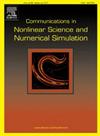Mixed finite element analysis for a modified Poisson–Fermi interface problem accounting for electrostatic correlations
IF 3.4
2区 数学
Q1 MATHEMATICS, APPLIED
Communications in Nonlinear Science and Numerical Simulation
Pub Date : 2024-10-09
DOI:10.1016/j.cnsns.2024.108385
引用次数: 0
Abstract
The Bazant–Storey–Kornyshev (BSK) theory [1], [2], [3] recently developed an important continuum framework to expound the nonlocal dielectric permittivity of ionic liquids due to electrostatic correlations, leading to a fourth-order modified Poisson–Fermi equation to model the electrostatic potential field in the solvent (e.g., the electrolyte), while the standard second-order Poisson–Fermi equation is still valid in modeling the electrostatic potential field in the solute. Thus an interface problem is formed between the fourth-order and second-order Poisson–Fermi equations through the interface of solvent and solute with jump coefficients, which has exerted tremendous impacts on applications of electrokinetics, electrochemistry, biophysics, and etc. In this paper, a type of mixed finite element method is developed to solve the proposed interface problem once for all variables: the electrostatic potential, electric field, electric displacement field, electrostatic stress as well as interactional force in the electrolyte in an accurate fashion, and its optimal convergence properties are analyzed for all variables in their respective norms. Numerical experiments are carried out through self-defined mathematical examples to validate all attained theoretical results. Furthermore, as a part of modeling verification for the presented interface problem that models the BSK theory, a practically physical example is investigated to validate the necessity of introducing the fourth-order modified Poisson–Fermi equation to describe the electrostatic correlation effects due to charge reversal phenomenon.
考虑静电相关性的修正泊松-费米界面问题的混合有限元分析
最近,Bazant-Storey-Kornyshev(BSK)理论[1]、[2]、[3]发展了一个重要的连续框架,用于阐述离子液体由于静电相关性而产生的非局部介电常数,从而产生了一个四阶修正泊松-费米方程,用于模拟溶剂(如电解质)中的静电势场、电解质)中的静电势场建模,而标准的二阶泊松-费米方程在溶质中的静电势场建模中仍然有效。因此,四阶泊松-费米方程和二阶泊松-费米方程之间通过溶剂和溶质的界面形成了一个具有跃迁系数的界面问题,这对电动力学、电化学、生物物理学等领域的应用产生了巨大影响。本文建立了一种混合有限元方法,对电解质中的静电势、电场、电位移场、静电应力以及相互作用力等所有变量进行一次精确求解,并分析了所有变量在各自规范下的最佳收敛特性。通过自行定义的数学实例进行了数值实验,以验证所有已获得的理论结果。此外,作为以 BSK 理论为模型的界面问题建模验证的一部分,还研究了一个实际物理示例,以验证引入四阶修正泊松-费米方程来描述电荷反转现象引起的静电相关效应的必要性。
本文章由计算机程序翻译,如有差异,请以英文原文为准。
求助全文
约1分钟内获得全文
求助全文
来源期刊

Communications in Nonlinear Science and Numerical Simulation
MATHEMATICS, APPLIED-MATHEMATICS, INTERDISCIPLINARY APPLICATIONS
CiteScore
6.80
自引率
7.70%
发文量
378
审稿时长
78 days
期刊介绍:
The journal publishes original research findings on experimental observation, mathematical modeling, theoretical analysis and numerical simulation, for more accurate description, better prediction or novel application, of nonlinear phenomena in science and engineering. It offers a venue for researchers to make rapid exchange of ideas and techniques in nonlinear science and complexity.
The submission of manuscripts with cross-disciplinary approaches in nonlinear science and complexity is particularly encouraged.
Topics of interest:
Nonlinear differential or delay equations, Lie group analysis and asymptotic methods, Discontinuous systems, Fractals, Fractional calculus and dynamics, Nonlinear effects in quantum mechanics, Nonlinear stochastic processes, Experimental nonlinear science, Time-series and signal analysis, Computational methods and simulations in nonlinear science and engineering, Control of dynamical systems, Synchronization, Lyapunov analysis, High-dimensional chaos and turbulence, Chaos in Hamiltonian systems, Integrable systems and solitons, Collective behavior in many-body systems, Biological physics and networks, Nonlinear mechanical systems, Complex systems and complexity.
No length limitation for contributions is set, but only concisely written manuscripts are published. Brief papers are published on the basis of Rapid Communications. Discussions of previously published papers are welcome.
 求助内容:
求助内容: 应助结果提醒方式:
应助结果提醒方式:


